When sales and marketing teams align towards a common goal and work effectively alongside one another, the business benefits by closing more deals and making more sales, quite simply, the better your sales funnel, the more money you will make.
By optimizing your sales funnel, you can drive revenue growth by pushing a higher percentage of prospects through each stage, thus making your marketing efforts do more and work harder.
And, the better you understand what a sales funnel is, how it works, and how to optimize yours, the easier you will find converting new leads into paying customers.
Let’s look at the sales funnel in more depth, make sure you get how it works, and share some actionable insights to help you have a higher conversion rate.
How to Optimize Your Sales Funnel
Know Your Audience Create Informative Educational Content That Answers Questions Capture Your Prospect’s Email Address Use Engaging Media to Stand Out Reviews, Testimonials & Customer Stories Create Convincing Supporting Content Use Strong CTAs Reduce Friction on Checkouts & Forms Be On-Hand To Help OutWhat Is a Sales Funnel?
A sales funnel (sometimes also referred to as a purchase funnel) is the process that a prospect goes through from their first interaction with your business until they become a paying customer or client.
Wider at the top, the goal of a sales funnel is to push qualified prospects from one stage to the next while dropping those who are either not the right fit for your business or who do not need your product or service at this time — the funnel narrows at each stage.
A typical sales funnel is usually visualized like this:
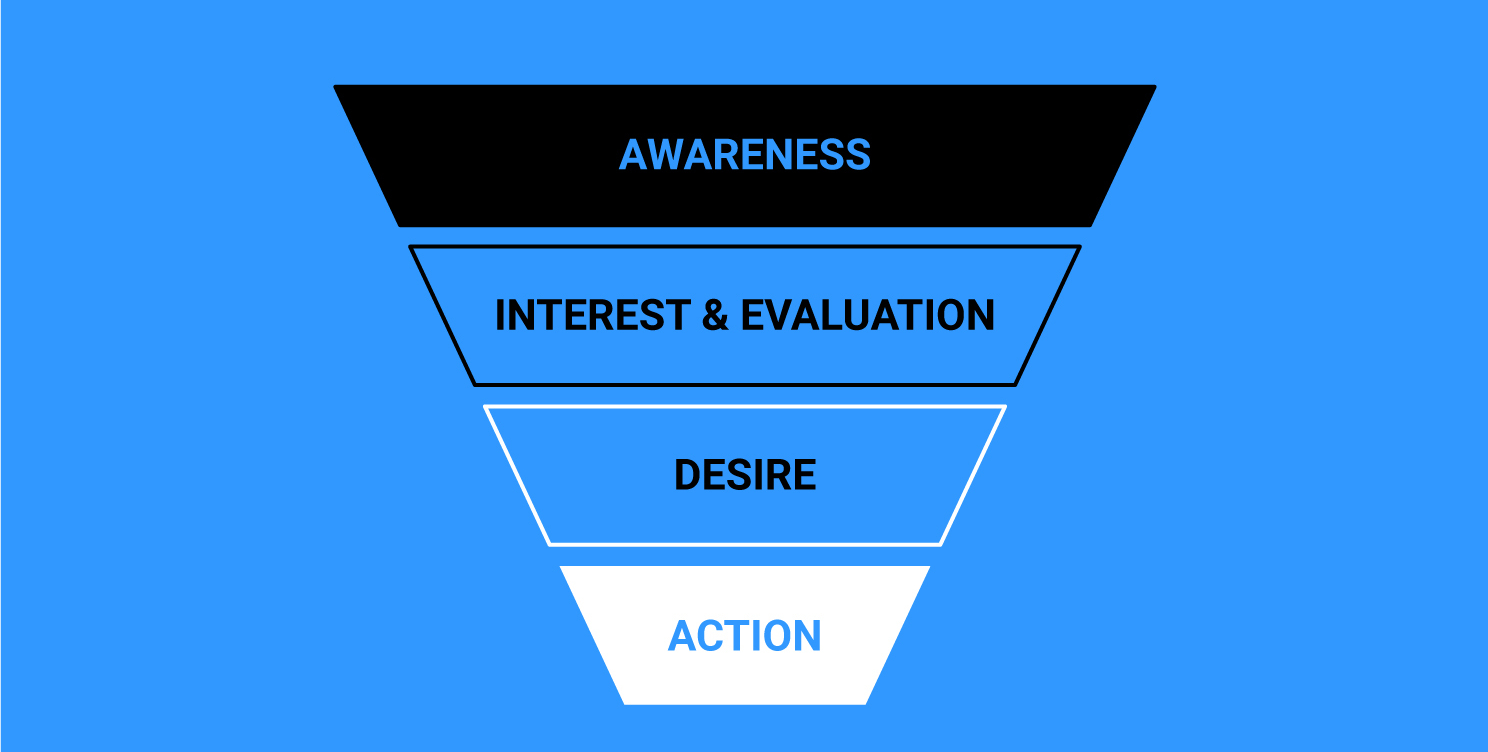
You may have heard the stages of the sales funnel referred to as being ‘top,’ ‘middle,’ or ‘bottom,’ with marketing activities often targeted at prospects in this way.
I will explore these different stages in more detail shortly, but to grasp an understanding of the concept, think of your sales funnel as the flow between browsers and buyers. At the top of the funnel, your sales prospects enter, and at the bottom, a percentage of these come out as completed sales and conversions.
The more of the prospects who enter and exit, the stronger your sales funnel is, and the more sales you will make. Key point — an optimized sales funnel leads to a higher conversion rate. Sounds simple, right?
How Sales Funnels Differ
You also need to understand how sales funnels differ to marketing funnels, given that these are sometimes used interchangeably. So what separates these?
Usually, the main difference is context. Traditionally, sales and marketing have typically operated as two different units within a business. Increasingly, however, these are merging.
The Lines Between Sales and Marketing Are Becoming Increasingly Blurred
When sales and marketing units unite, both channels can be more effective than when they operate in their own silo. But while there is ultimately an overlap, a marketing funnel is that which generates awareness and nurtures a prospect to the stage where they are ready to consider making a purchase — this is typically known as the top of the funnel.
The sales funnel, on the other hand, takes the prospect from that point of consideration and converts them into a transaction. The reality is that, for many businesses in 2020, the sales and marketing funnels will be joined, but it is important to remember that the sales funnel must always follow on from the marketing funnel.
Why Is a Sales Funnel Such an Important Part of Your Strategy?
Whatever marketing tactics you use to acquire traffic, the reality is that half of your prospects won’t be ready to convert at that time. And that is where funnel optimization comes in.
Without optimizing it, you will be losing prospects who could have turned into paying customers, but who, for one reason or another, didn’t. And there are few things more frustrating as a marketer than knowing your efforts could have been better at the sales stage.
You can influence the purchase decision of prospects and improve your conversion rate — which is why it is such an important part of your wider sales and marketing strategy. If you can learn how to improve each of the stages of your sales funnel, you will be able to convert a higher percentage of prospects.
To improve and enhance, you need to be able to visualize your sales funnel and utilize this as a framework to analyze and identify opportunities to make improvements.
A few of the clear benefits of an optimized sales funnel include:
Making more sales due to a higher percentage of prospects making their way through the full funnel.
It will help identify the right marketing strategy by ensuring you targeting the right audience at a particular stage in their purchase journey.
An understanding of the reasons why your product or service isn’t right for all of your prospects, therefore giving an opportunity to identify ways to serve their needs.
It gives you an edge over your competitors that are jot dedicating the time and resources to optimizing their funnel.
In short, without a sales funnel, you are shooting in the dark and hoping for the best when it comes to turning browsers into buyers.
How Sales Funnels Work: the Different Stages
To begin to understand how a sales funnel works, let's look at the acronym AIDA which makes it easier for you to remember each stage. There are typically four stages which exist within a sales funnel and represent the different mindsets which a prospect goes through on the journey to becoming a customer:
Awareness
Interest
Decision
Action
It is these stages which you need to optimize to turn a higher percentage of prospects into customers, so let’s look at each of these stages in a little more detail, including examples of those doing a great job.
Awareness
The awareness stage is where your prospects interact with you for the first time.
It is when they become aware of who you are as a business, learn about the products or services you offer, and learn why you are different from your competitors. Keep in mind, they are probably not even considering buying anything at this stage.
Awareness could be a result of a variety of things, like:
A Google search and landing on your website. The prospect saw your content shared by a friend on social media. An offline action.Examples like this are the first time someone interacts with you, and an opportunity for you to demonstrate your strengths and encourage engagement in one or more ways.
What Customers Are Looking For
The mindset of the customer here is to find the answer to a question or a solution to a problem that they have, with this often being found in blog posts, social media content, or other top-level educational content.
A prospect at this stage has low value, but success here is about being helpful, rather than pushing for a sale. You should be focusing on showcasing your expertise to encourage them to go to the next stage of the funnel.
This retirement income calculator from Vanguard is a great example of a piece of content at the awareness stage, given that it clearly helps to answer the question of how much income an individual will need during retirement.
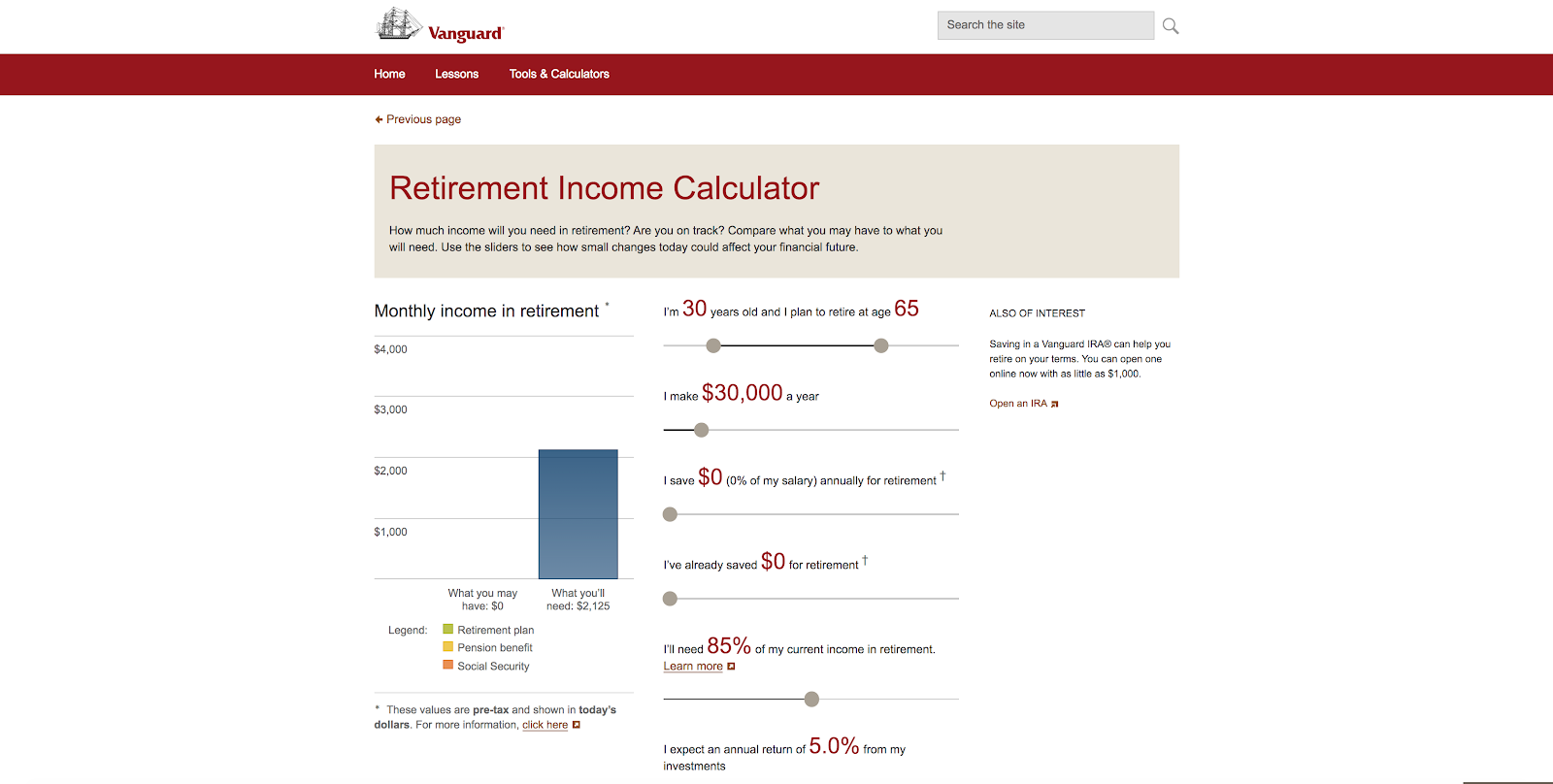
The tool doesn’t push a sale and is simply intended to educate and help; exactly what a successful piece of content to raise awareness should do.
Interest
Those who move through the funnel to the interest stage will now be looking to determine whether or not your product or service is right for them and whether it will fulfill their needs sufficiently.
If you have pushed a prospect through the awareness stage and into the interest stage, you have got their attention, and they have identified that they have a need and are looking to find the best solution. This is very much a research phase, where you have got a real opportunity to educate and inform as to what the perfect solution looks like and how your offering could meet their need.
At this point, a sale still isn’t usually imminent, and the prospect needs to identify you as a strong contender; this is your opportunity to prove to them why you fit the bill, or equally as important, why you don’t.
It is the stage where you need to help them to identify you as the right solution, and this is the stage where the business needs to be establishing trust and building a relationship.
The questions which a prospect has at this stage are far more specific and should be thought of as a follow on to the awareness phase.
Having a USP
Having a unique selling point is key here, as is communicating that message effectively. One brand that does a great job of this is Unbounce.
Let’s imagine you have identified that you need to create better landing pages, but don’t have developer resources available. Unbounce’s landing pages product page clearly demonstrates how their solution could help someone in this position, highlighting quick-to-use templates and own domain publishing alongside the appeal of doing so without writing code or needing a developer.

At the end of the interest phase, the prospect should have identified you as a contender.
Decision
By the decision stage, the customer knows that they are going to buy but is likely still considering more options than just yours.
This means they are specifically considering things like price and the different options available to them as well as looking to understand the quality of your product or service, and are looking to make sure they are getting the most suitable purchase at the right price.
Strong tactics at this stage can vary depending on the type of business that you are, and different approaches are often needed,
A great example here includes the use of social proof. Again, Unbounce does a great job of using blog content, such as this long-form case study, to demonstrate the impact which their solution combined with a great strategy can produce — showcasing social proof and an example of what you could achieve if you sign up and use their product.

Action
When a prospect gets to the end of the sales funnel, they take action and are ready to make a purchase from you.
It is when a prospect becomes your customer that you have the perfect opportunity to delight and encourage repeat purchases in the future. Your prospect has their hand on their wallet, and they are ready to open it; you just need to give them that final push to convince them to do so.
But how?
Often, this stage is about helping prospects to overcome any final hurdles they have. They have identified that you are the right product or service, but there may be something they need convincing on. eConsultancy reports that 83% of online shoppers need support to complete a purchase, and this is often where you can go that extra mile to get prospects through this final stage.
Offering a demo or trial of a product or service is a great way for a prospect to confirm their decision that you are right for them. Look at the use of a trial period to allow the prospect to try your solution out for themselves; the most-relatable example is Amazon Prime, where you can enjoy 30 days totally free of charge.
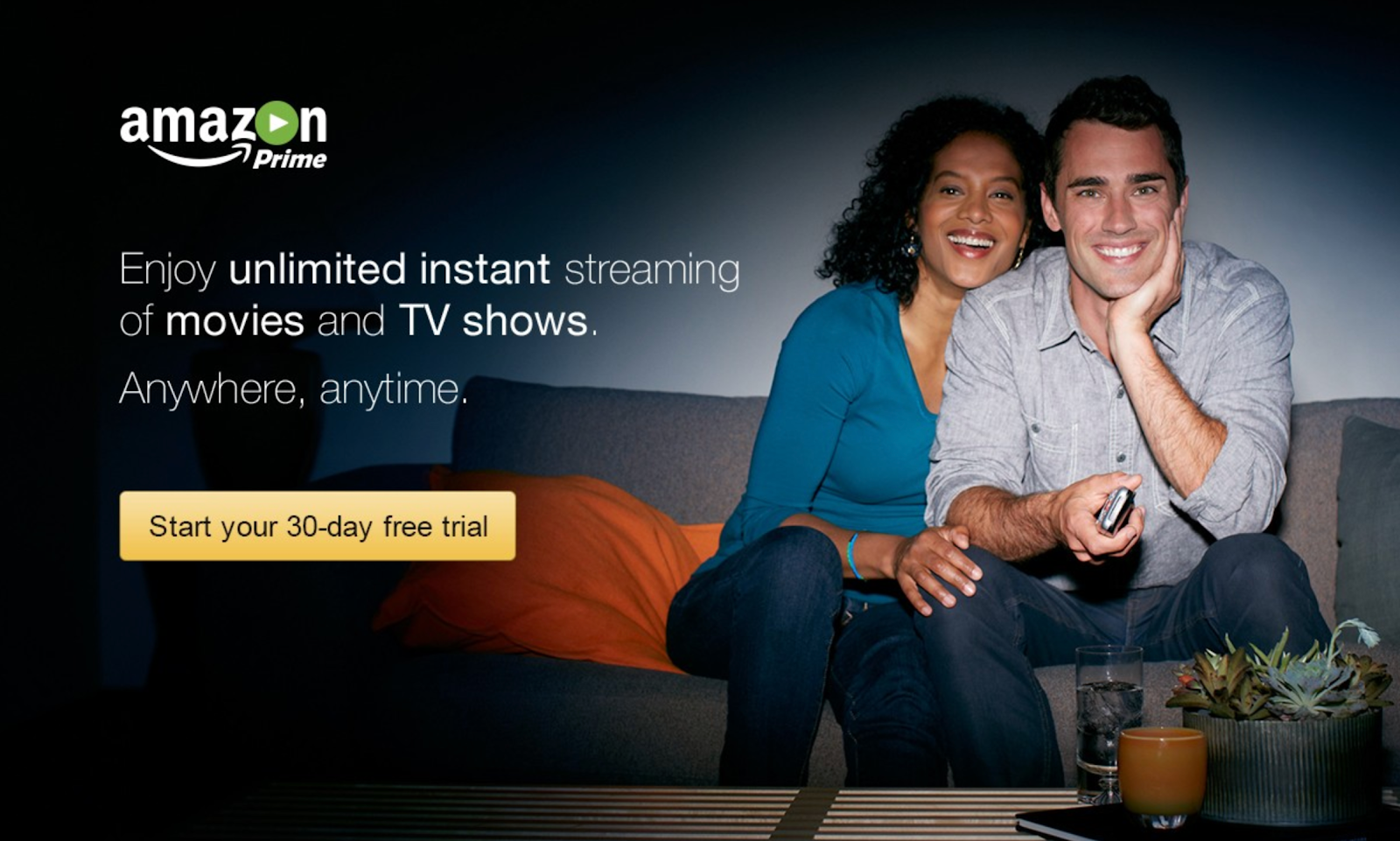
Ways to Optimize Your Sales Funnel For Success
No sales funnel is perfect, but you have a real opportunity to influence prospects and reduce those who drop out and continue to nurture those who are simply not ready to buy.
Here are 9 ways in which you can optimize your sales funnel to help make it convert better.
1. Know Your Audience
If you don’t know enough about your audience, how can you optimize your sales funnel?
The more you know about your prospects, the better you can market to them and convert them into paying customers. If you are targeting the wrong customer, or have your sales funnel set up to target the wrong personas, you are wasting time and money. It pays to get this right.
First, you need to build these personas, and I recommend checking out this guide from HubSpot to help you do this.
You also need to understand your competitors, especially those who you know are performing well. You can use our Traffic Analytics tool to help you gain insight into your competitors’ traffic sources and top-performing content to understand what is working for them and what is resonating with their audience.
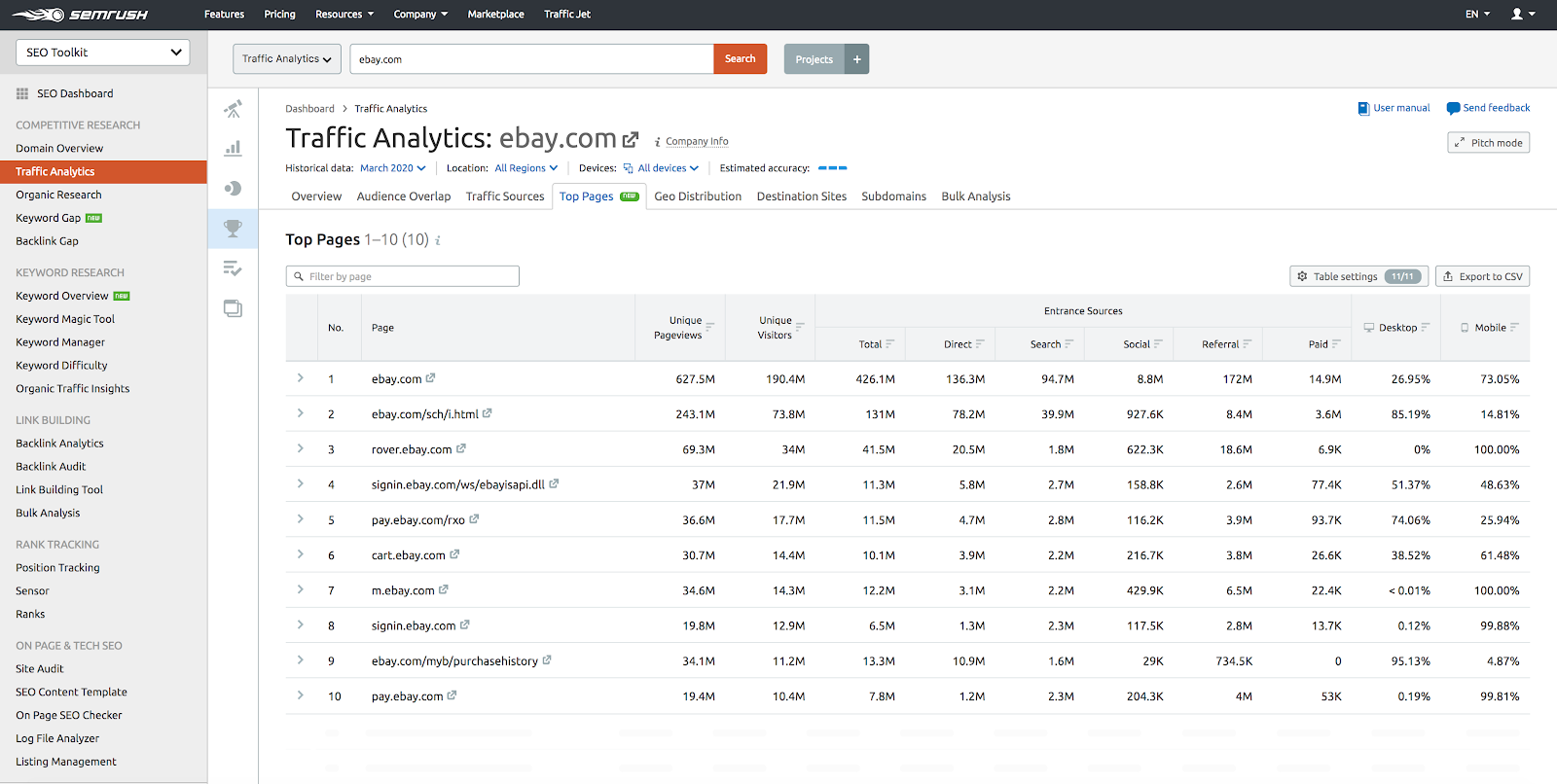
Or, alternatively, use Market Explorer to better understand your market, including audience interests and key demographics.
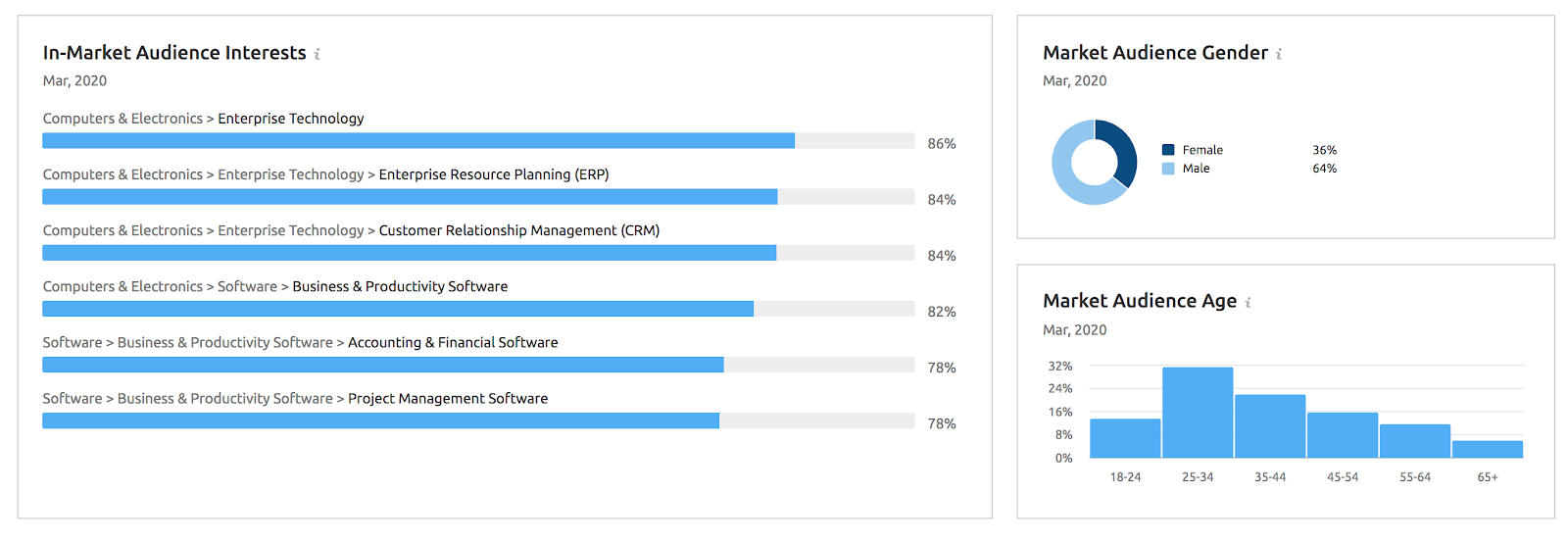
2. Create Informative Educational Content That Answers Questions
According to research by Conductor, educational content makes consumers 131% more likely to buy from you.
When you create great content that educates those currently looking for solutions to their problems, you position yourself as an expert, immediately build trust, and get recognition as being helpful.
As recommended by Andy Crestodina, Jonathan Auugray, and Joel Klettke in our “Connecting Content to Sales: Missing Links and Creative Fixes” webinar, start by thinking about your personas and asking, “What do they ask themselves every day? What are their problems? What solution are they looking for?”
Brand Example
A great example of a brand that is doing a great job of creating content at the awareness stage is Pipedrive. They create and publish content assets that both raise awareness of the SaaS tool amongst their target buyer personas and help solve a problem.
Their ‘Cold Calling Scripts: 25 Sample Sales Templates & Tips’ guide ranks at the top of Google when a prospect searches for ‘cold calling scripts’ and helps to position the brand as experts in sales (their product is a sales CRM).
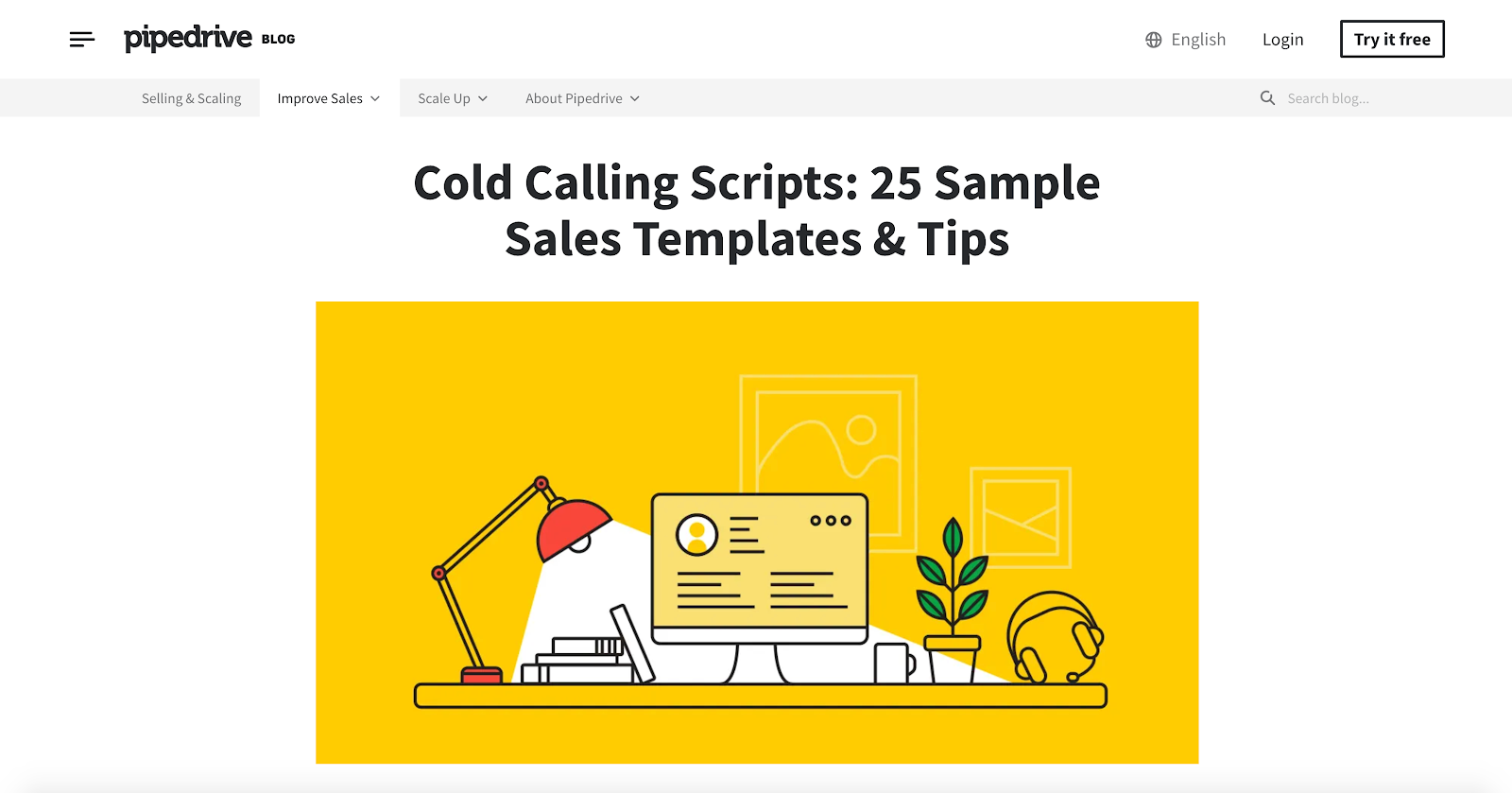
Keywords and Questions
A great way to identify opportunities to create content that targets the awareness stage of your sales funnel is by finding the keywords and questions which your target personas are searching for.
One way to uncover topics and keywords which you could create awareness-based content around is to use the Semrush Keyword Magic Tool, where you can enter a keyword, domain, or URL (let’s say, of a competitor) and see ideas.
Sticking to the example above, turn to the tool and enter the keyword ‘sales pipeline’ to see a wealth of ideas. You can even choose to filter by ‘questions’ to help you to dig deeper to find opportunities.
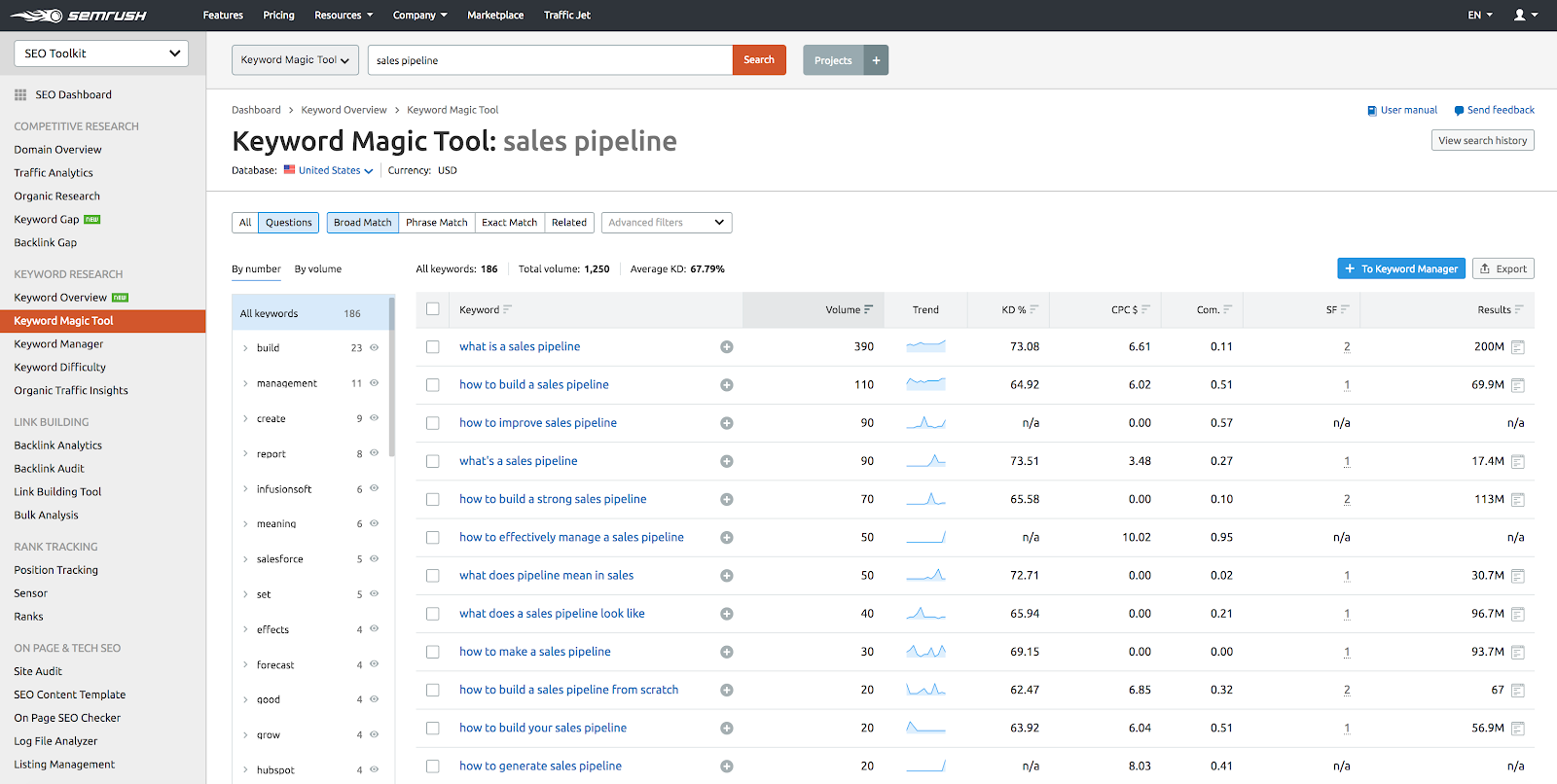
You can find more great tips and insights on content marketing and the sales funnel here.
3. Capture Your Prospect’s Email Address
To nurture a prospect through your sales funnel, you need to build a relationship and earn trust, and without their email address, you will find this difficult to do. A prospect being willing to share their email address with you is one of the first signs that they are open to building a relationship with your business, and have an interest in your offering.
Getting Email Addresses
Hopefully, you are already creating compelling content at both the awareness and interest stages, and this can be a great opportunity to capture email addresses. In the simplest form, using a visible sign-up form alongside content can be highly effective. After all, what better time to offer a user the chance to sign up whilst they are already engaging in your content.
Just be sure to clearly state what they can expect if they sign up.
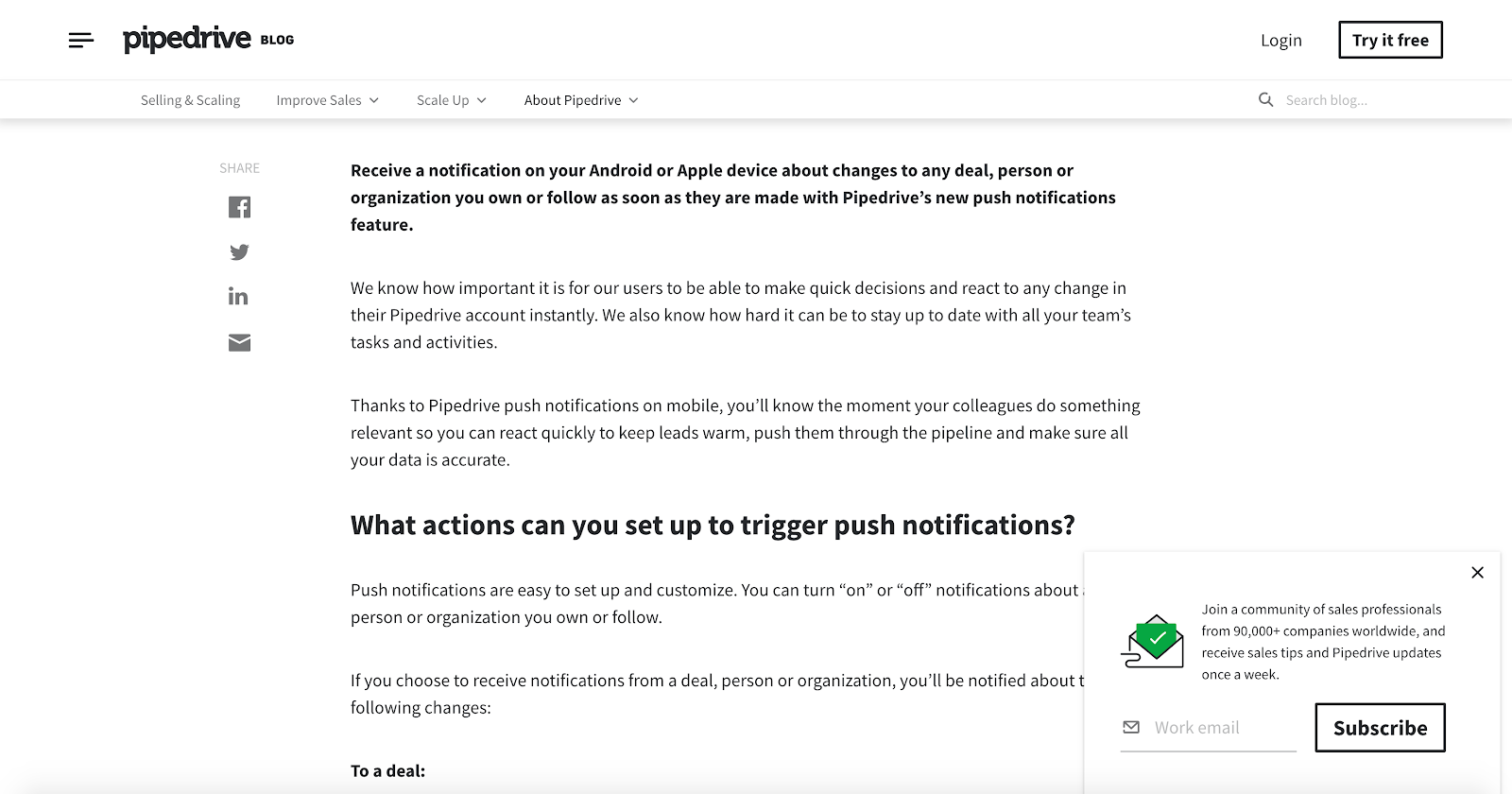
Often though, this isn’t enough, and the sign-up rate is low.
Instead, consider offering your best content only once a prospect signs up and enters their email address, using custom landing pages that clearly showcases the quality content you are offering to increase sign-ups. A great example of this in practice is HubSpot’s downloadable persona templates.
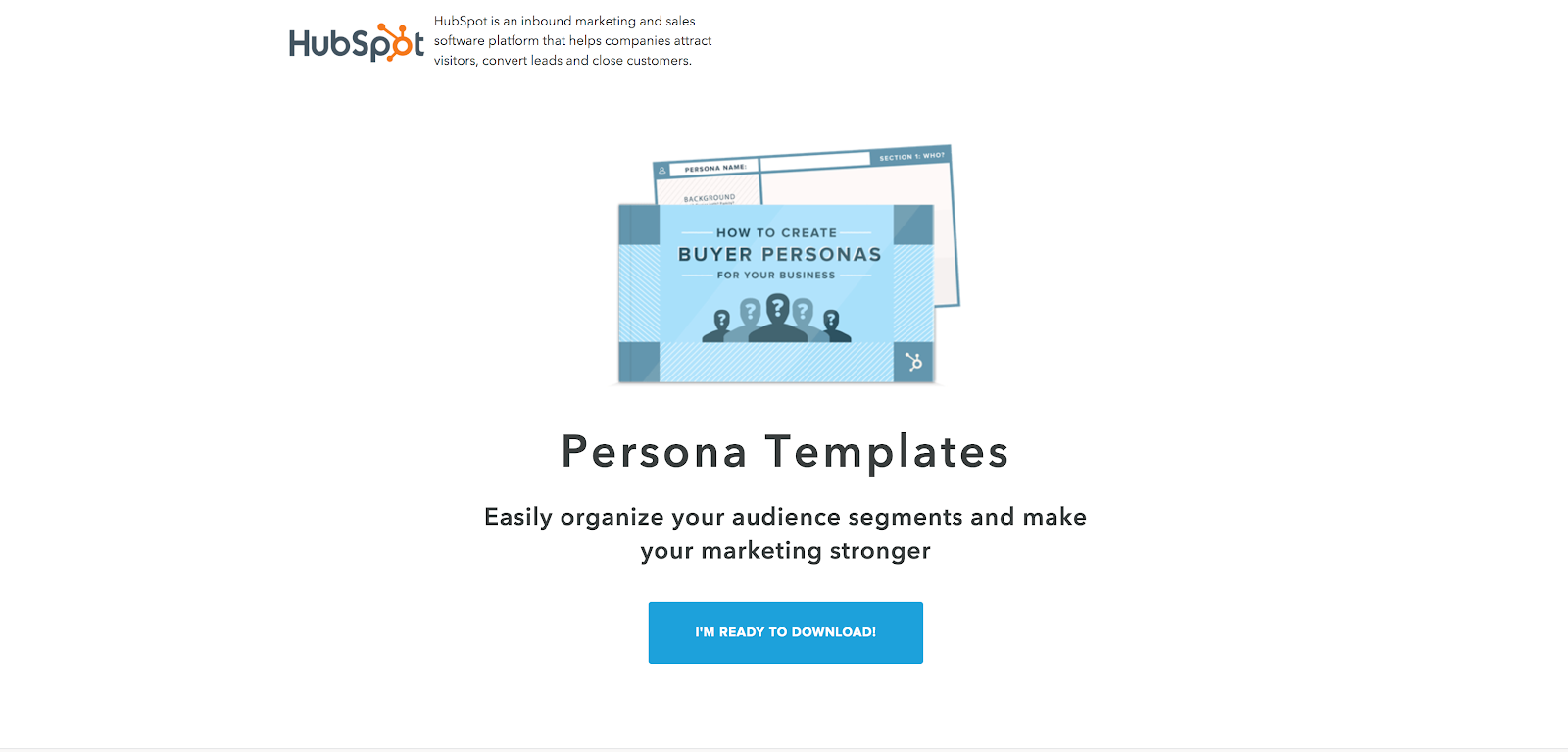
4. Use Engaging Media to Stand Out
Once you have the attention of a prospect, you need to work hard to maintain this attention and stand out from the crowd. One of the best ways you can do this is by using engaging media to help prospects explore and understand your products or services.
After all, at the consideration phase of the sales funnel, the more you can do to help someone understand why your product is right for them, the stronger your chance of getting the conversion.
Examples of Engaging Media
Great product photos go a long way to help sell products, and going beyond studio shots really helps you to stand out amongst your competitors. Just look at how Fitbit uses showcases features through on-device images:
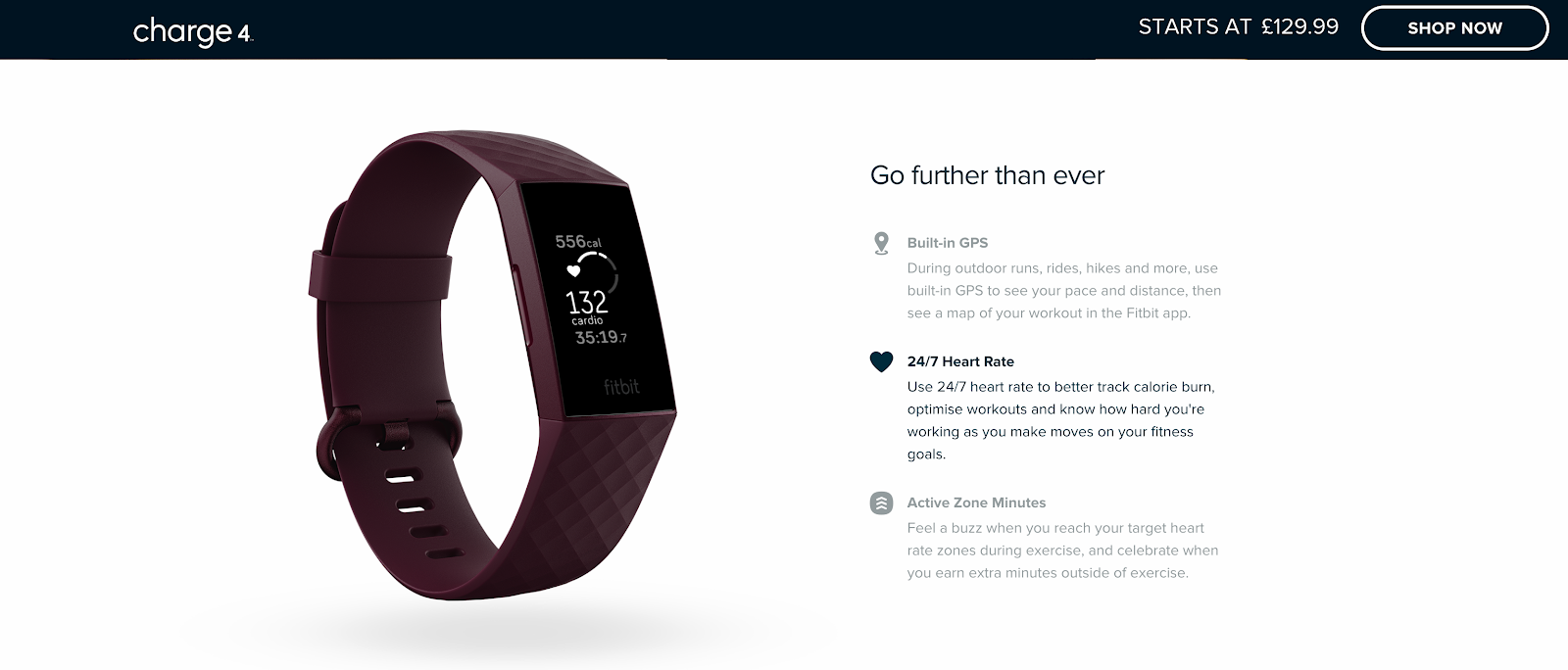
Or how they highlight the key features of the product with standout images:
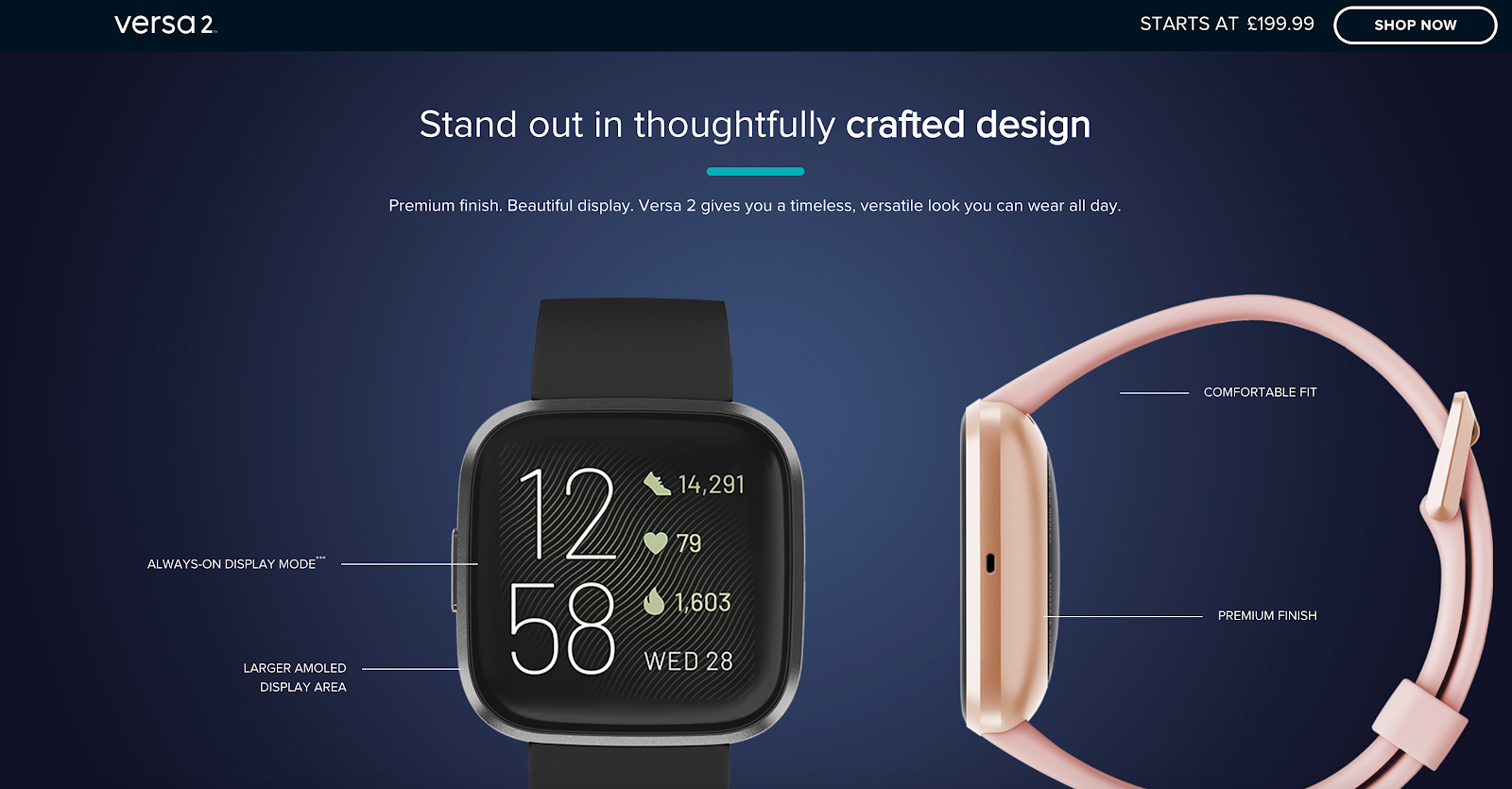
Alongside helping to showcase their app to work alongside the device:
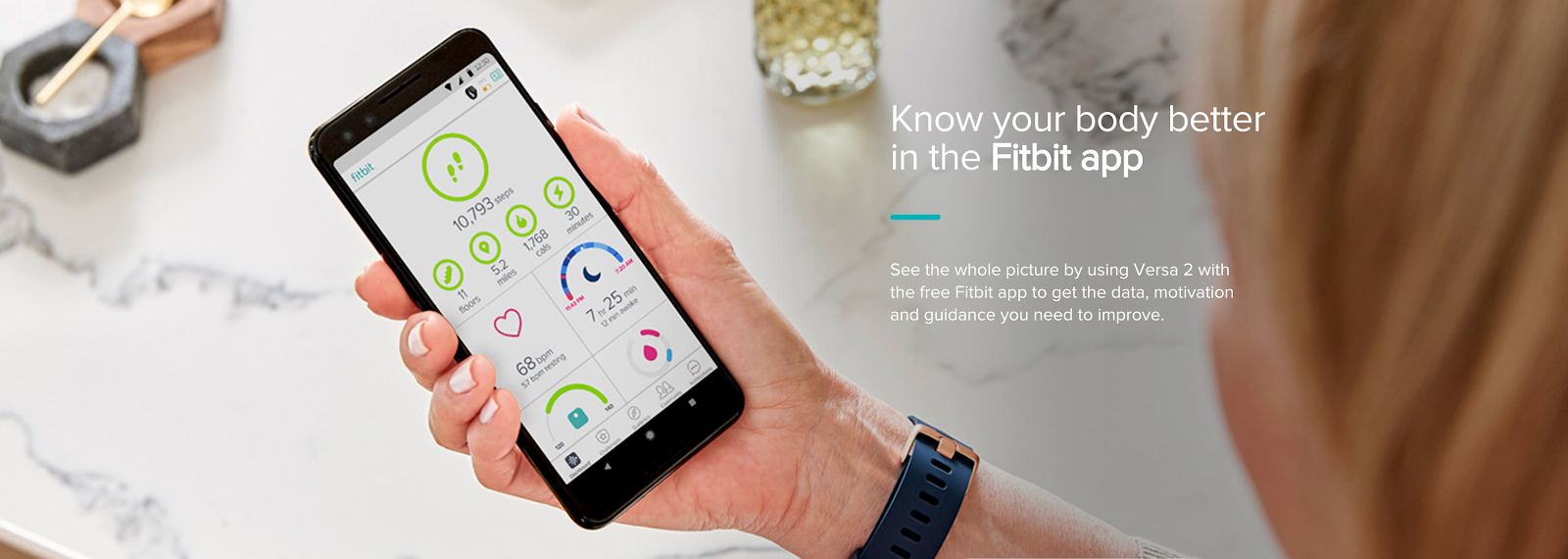
Using bespoke imagery, which truly stands out, goes a long way to help sell a product.
With the technology now available, you could consider going one better. Look at how Apple uses AR to help customers truly get to grips with the Apple Watch:
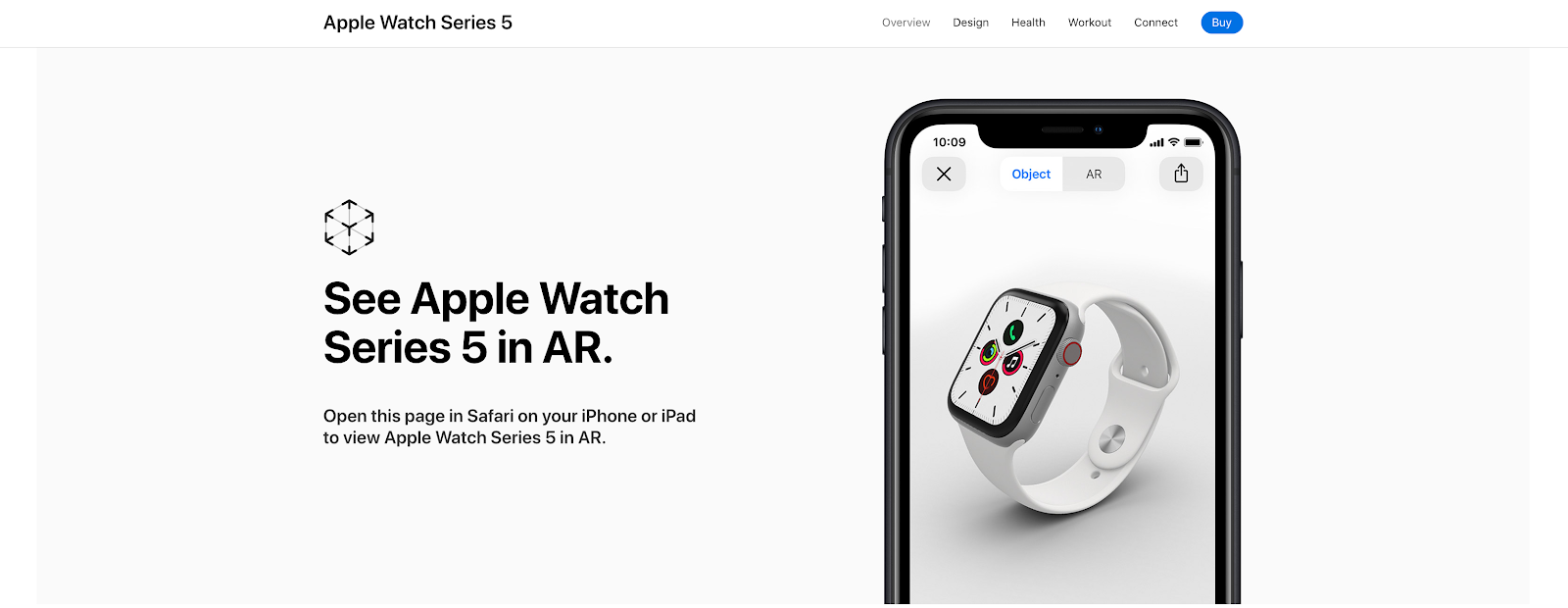
You just need to stand out to help prospects connect with your products or services, and engaging media, including rich images, video, and even, AR can be the perfect way to do that.
5. Reviews, Testimonials & Customer Stories
Trust plays a huge part in a successful sales funnel. After all, building any relationship is usually based around trust, and it is vital that you are able to work trust and social proof into your funnel.
Thankfully, it is easier than ever to collect reviews of your business and products, not just to display on your product or service pages, but also on third-party platforms. Notice how Best Buy displays product ratings alongside the price?
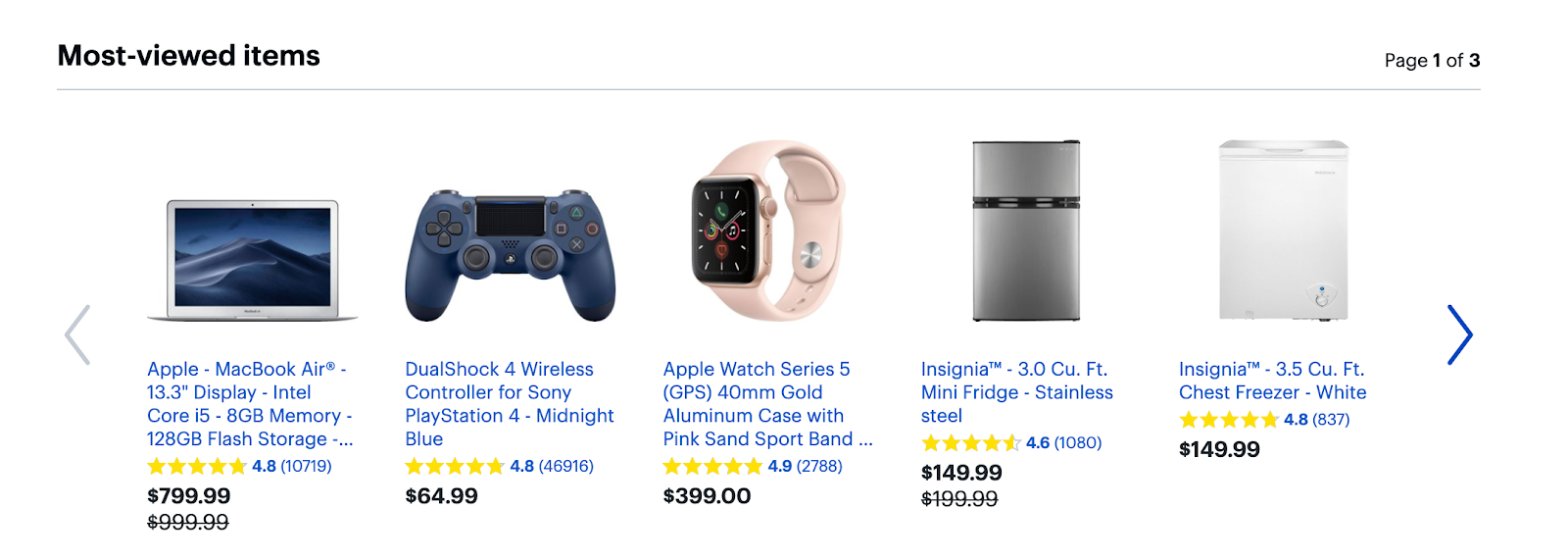
This helps to establish trust, especially when provided alongside the number of reviews. After all, a 4.8/5 rating from 10,719 reviews isn’t bad at all.
Equally as important are testimonials, awards, and customer success stories. Remember, this is a trust-building exercise to showcase how you stand out against your competitors.
You need to be asking yourself how you can demonstrate the strength of your offering. See how Teamwork combines standout stats around their customer numbers alongside customer success stories and an indication as to who is using their platform?
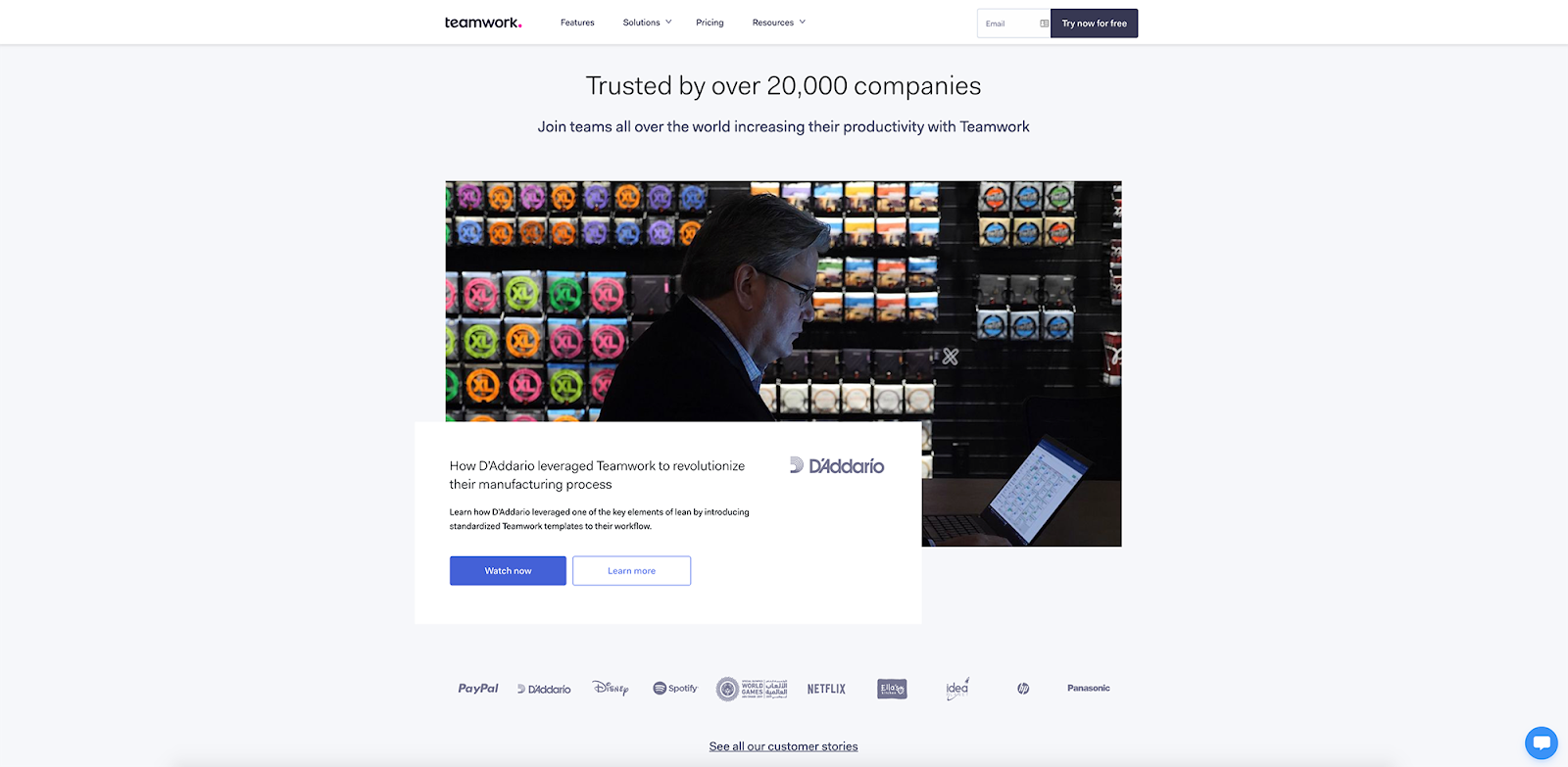
At the end of the day, if a tool is good enough for Disney, there is every chance it is good enough for you.
Also think about whether you re able to land testimonials from your clients and customers, alongside more detailed case studies and stories as these can also go a long way to showcasing your strengths, just like these do for Global Payments:
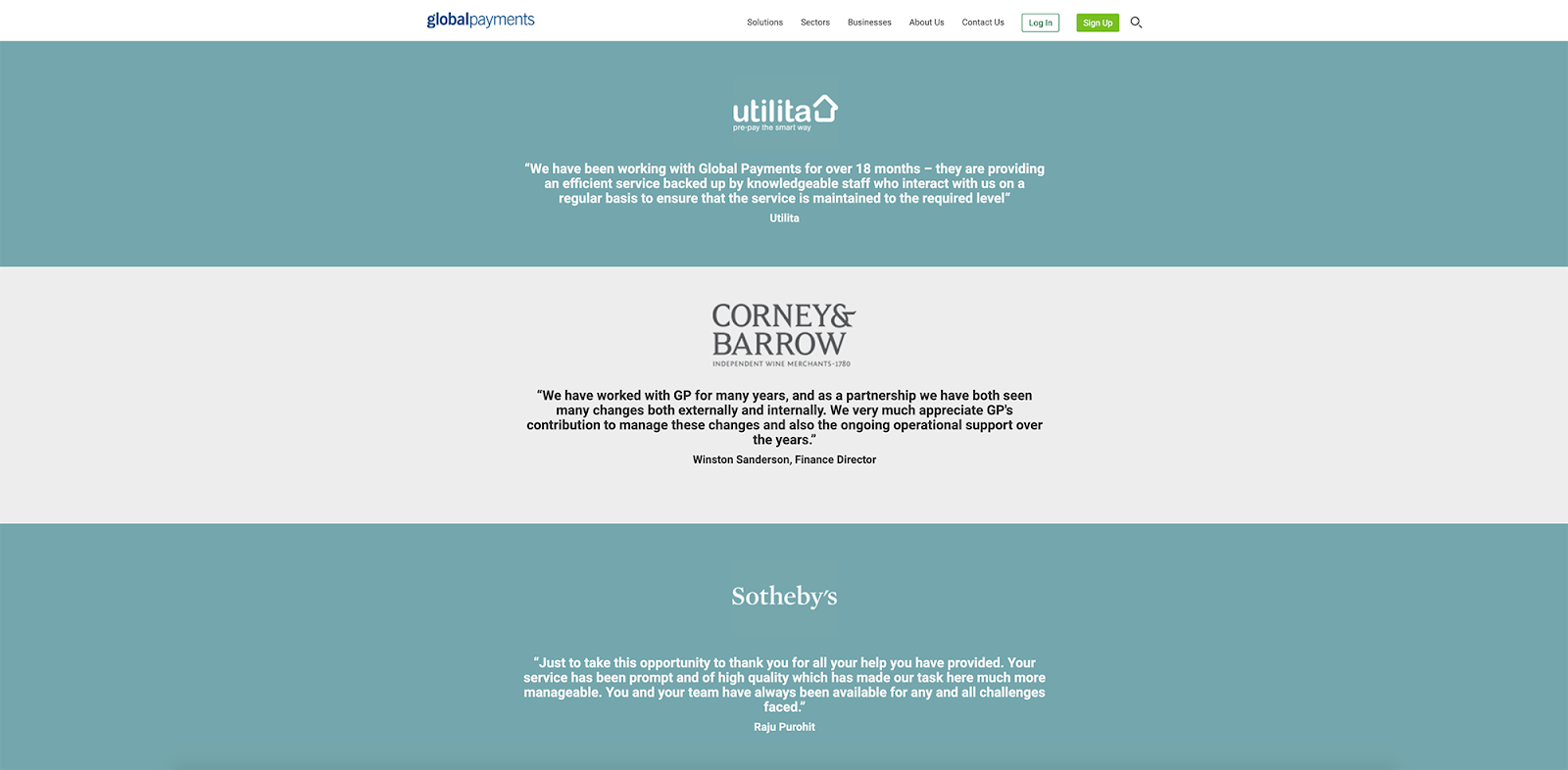
But that is not all. If you have been featured in the press, be sure to shout about it, just like Calendar.com does:
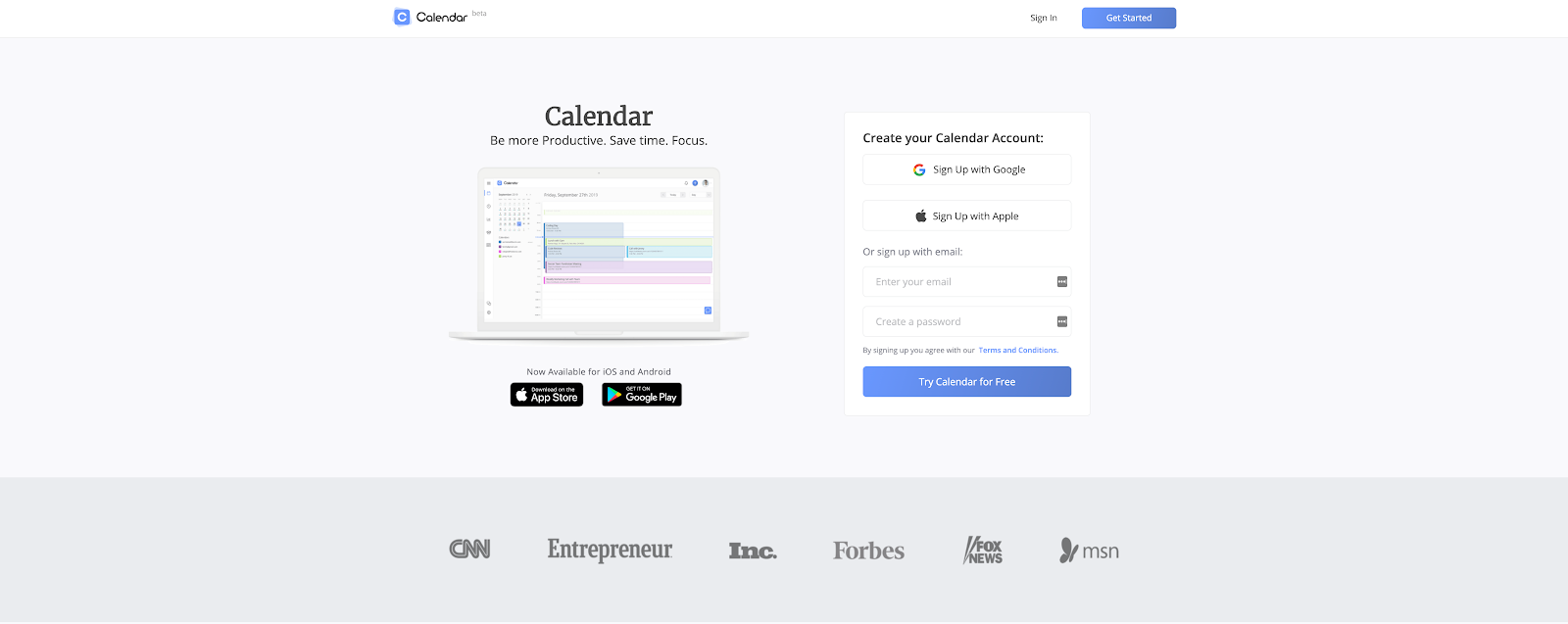
6. Create Convincing Supporting Content
By the time a prospect is at the decision stage, they are considering your offering in great detail, while also comparing this to competitors.
You need to be thinking, at this stage, about the content you can create to support the sales funnel and really showcase not just that the customer needs what you offer, but that they need it from you. Alongside creating social proof that we have looked at above, think carefully about how you can further build trust and confidence through content such as:
Shipping & returns policies
Mission statements
Team pages (if you’re offering a service where the customer will be working with your team)
It is time to go and speak with your sales and customer service teams and figure out the questions commonly being asked just before a sale converts — you can then use these insights to create content around these topics.
As an example, Boohoo does a great job of demonstrating a simple and straightforward returns process:
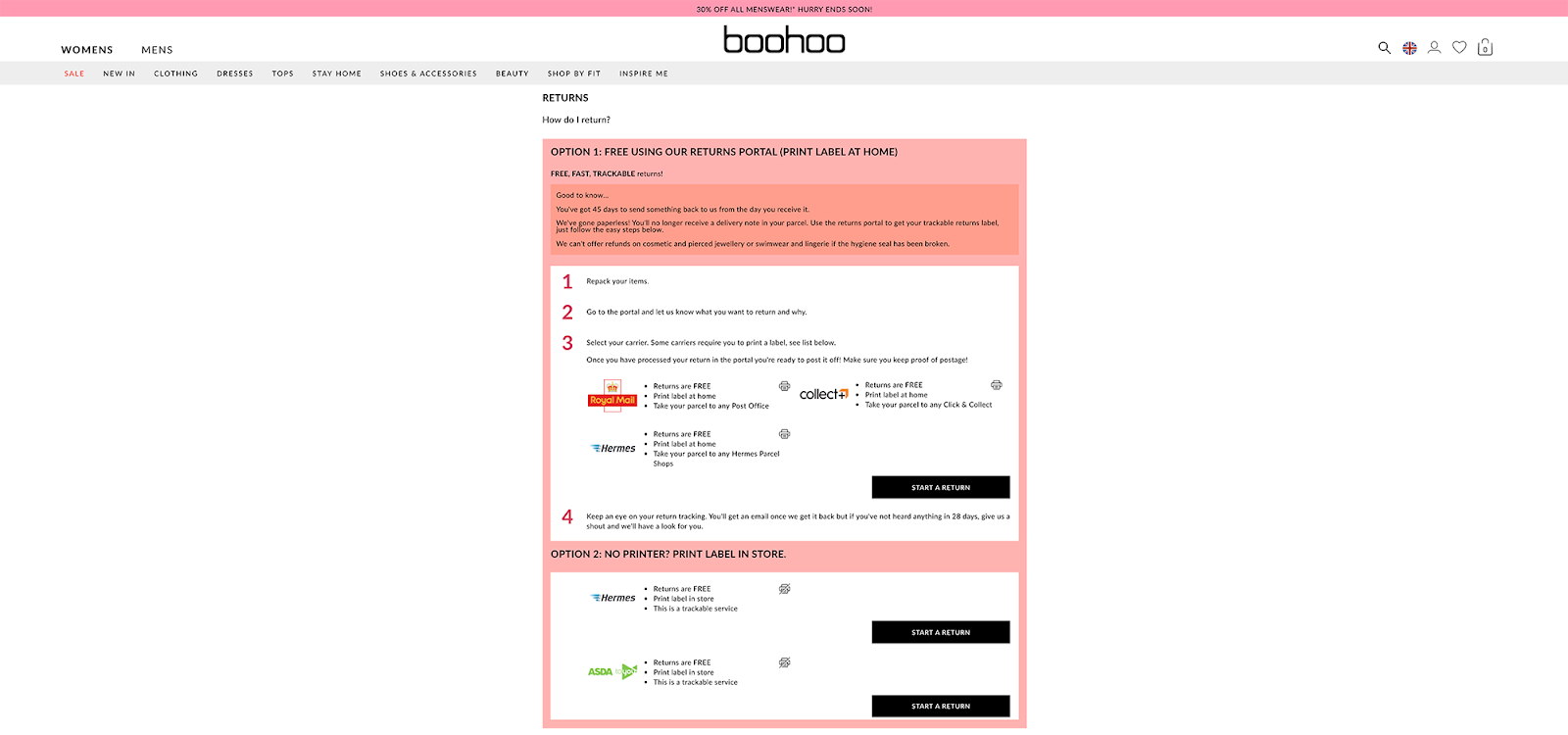
It is easy to create confidence when your prospects can see that you are helping to make their decisions easier.
7. Use Strong CTAs
It might sound simple, but ensuring you use strong CTAs (calls to action) is a great way to optimize your sales funnel, yet one which is often overlooked for more complex tactics.
At the end of the day, if you have managed to take a prospect right through to the last stage of the funnel, you don’t want to make the mistake of not clearly showing them what they need to do next.
You need to use a clear and straight to the point CTA (call to action), which motivates a prospect to take the action you want them to take.
That could be things like:
Schedule an appointment today!
Request a callback.
Book now!
Start your free trial!
Join today!
Netflix, as an example, uses a really clear CTA to encourage prospects to ‘try it now.’

8. Reduce Friction on Checkouts & Forms
Cart and checkout and form abandonment are common reasons why prospects drop out of a sales funnel, despite many being ready to buy.
You don’t want to be losing sales and conversions because there is friction at this stage. Research suggests that 69.23% of online consumers who put something in a cart leave without purchasing, with common reasons including:
Extra fees and costs (shipping, etc.) are too high.
No ability to checkout as a guest.
A long or complicated checkout process.
A lack of trust signals when entering card details.
An unfair or unclear returns policy.
A lack of payment options.
Many of these same principles can be applied to lead generation forms as well.
You can learn more about optimizing your checkout process in this guide or about improving the conversion rate on forms here.
9. Be On-Hand To Help Out
If your prospect has questions just before they convert and once they are at the action stage of the funnel, are you on hand to help out?
If you are not, you need to be. Ensure you have got really simple ways in which prospects can get in touch to ask you questions where they will get a quick response.
But remember, this doesn’t have to just be phone numbers and email addresses. In 2020, prospects usually want instant answers.
Drift does a great job of demonstrating how you can use live chat and chatbots to answer common questions, allowing the platform to take control in the early stages before handing over to a salesperson in the event that more needs answering:
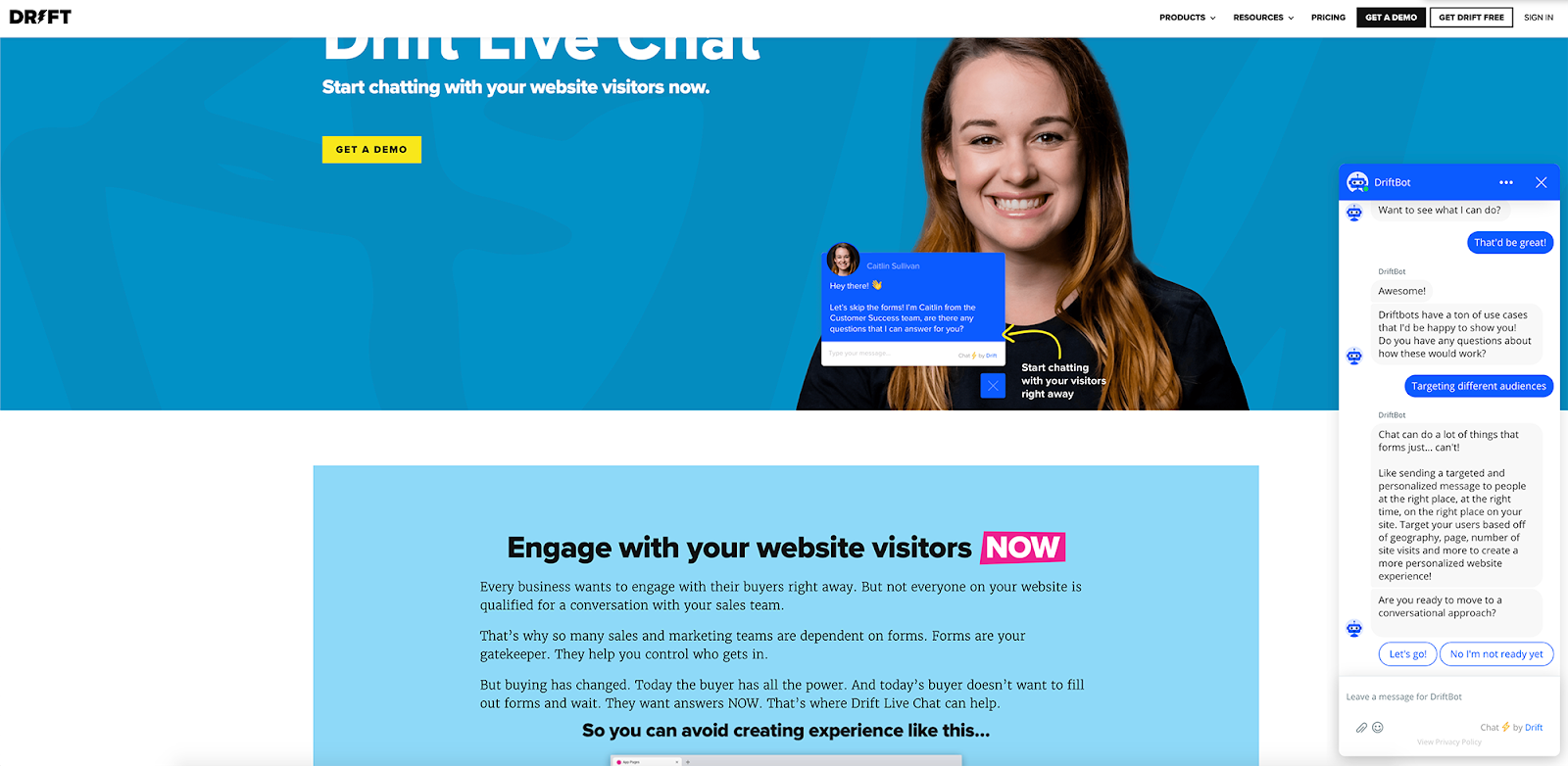
The more you can be there for your prospects at this stage, the more deals you will close.
To Recap
Optimizing your sales funnel is something every business needs to be doing. If you don't, you will unnecessarily lose prospects to your competitors.
By taking the time to understand what a sales funnel is, what yours looks like. and how you can improve it, you can make your marketing work harder for you and improve your conversion rate — helping to better the goal of most businesses, which is to make more money. So don't forget the steps you must take to succeed.
Innovative SEO services
SEO is a patience game; no secret there. We`ll work with you to develop a Search strategy focused on producing increased traffic rankings in as early as 3-months.
A proven Allinclusive. SEO services for measuring, executing, and optimizing for Search Engine success. We say what we do and do what we say.
Our company as Semrush Agency Partner has designed a search engine optimization service that is both ethical and result-driven. We use the latest tools, strategies, and trends to help you move up in the search engines for the right keywords to get noticed by the right audience.
Today, you can schedule a Discovery call with us about your company needs.
Source:





